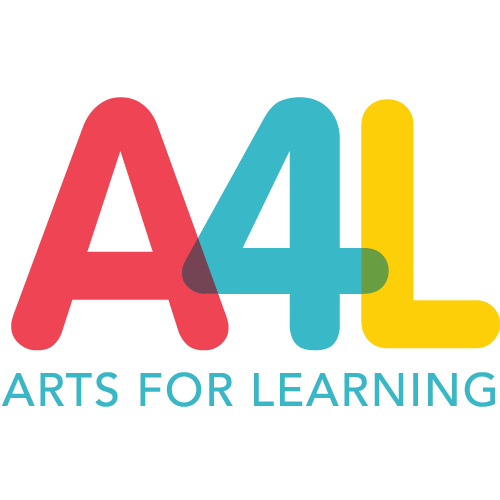Arts for Learning Centers
[ngg_images source=”galleries” container_ids=”6″ sortorder=”34,38,35,36,37,39″ display_type=”photocrati-nextgen_pro_slideshow” image_crop=”0″ image_pan=”1″ show_playback_controls=”1″ show_captions=”1″ caption_class=”caption_overlay_bottom” caption_height=”70″ aspect_ratio=”1.5″ width=”100″ width_unit=”%” transition=”fade” transition_speed=”1″ slideshow_speed=”5″ border_size=”0″ border_color=”#ffffff” ngg_triggers_display=”always” order_by=”sortorder” order_direction=”ASC” returns=”included” maximum_entity_count=”500″]Recently, while observing an Arts for Learning after-school class, I noted the teacher’s comments and instructions. They seemed pertinent to any and every class— a guide for learning. Her directions were explicit, and she demonstrated first. She moved around the room, acknowledging and modifying each student’s efforts.
“We need to try. We need to challenge ourselves.”
“You’ll lose your balance—you’ll be okay!”
“Trust the other person; they’re here to support you.”
“Friends are helping you to work on a skill.”
“You tried it! You made it!”
“Don’t force anything. Fall forward.”
The emphasis was on being supportive—giving permission to be imperfect. Through stretching oneself, the intention was to build strength and flexibility over time, while always seeking balance. “Proper” technique was explained and exemplified, complete with variations from which to choose to best suit individual proclivities. Students practiced as a class and in pairs, all the while working on one’s own skills. There was a gentle rigor in a truly supportive space that fostered observation, attention, consideration, and an awareness of the mind and judgement.
Everyone seeks balance, and schools are no different. They are tasked with ensuring that students have mastered certain criteria from an array of subjects. There are consequences for not mastering criteria, for the schools, principals, and teachers, but mostly for the students. When principals must weigh which courses will yield the most test-ready results, the arts are typically the first subjects eliminated from the schedule – but is balance achieved?
When visiting Fienberg-Fisher K-8 Center last week, I had the joy of watching a teacher I had observed there about 10 years ago, in a very different class. Back then, Susana Saumell was an Arts For Learning (A4L) GetSmART teacher, implementing a program centered on integrating the arts into the curricula of other subjects. I still remember visiting her elementary classroom with learning centers, where small groups of students could work on arts integrated projects that also enhanced reading and other essential skills. It left an indelible mark—a model of how engaged learning can not only improve basic skills, but also augment learning itself.
I didn’t even realize that Ms. Saumell now teaches 5th grade math, a subject with which many students struggle, as I was observing A4L’s after-school program there.
The A4L after-school program at Fienberg-Fisher this year is in its infancy; it started this winter and is unique in its design. One afternoon per week, teaching artist Jean-Michael Vissepo leads an after-school class in visual arts, while another afternoon each week, Ms. Saumell teaches yoga to the same students. In addition to visual arts, music or dance, A4L is broadening its after-school offerings with a yoga class that dovetails perfectly with the arts class. Ms. Saumell not only seemed to be a master yogi, but as a veteran A4L Teacher, she exemplified the A4L model that applies to arts education and arts integration: focusing on the process.
In fact, aside from all the physical and mental health benefits of yoga, the opportunity to learn completely different information using a similar approach that focuses on attention and process reinforces the “learning muscles.” Students are engaged in intensive practice without stress. They are honing techniques while discovering their own strengths and limits. Similarly, the arts provide a unique experience that “repositions” one’s view. The arts require flexibility of mind and they strengthen understanding, while broadening knowledge and skills. Like yoga, the arts balance thinking and doing; individual and social experiences; new perspectives and positions; learning by doing.
Fienberg-Fisher K-8, located in the heart of South Beach, is a Title 1 School. 86% of the students receive free/reduced lunch. 88% of the students are considered “minorities.” Predominantly Hispanic, with many students who speak other non-English languages, the task of educating the student population, mainly children of those who work in the hospitality industry on Miami Beach, focuses largely on reading and math skills. The arts, as part of an elective program in the school, are limited. An emphasis is placed on testing and skill building for reading and math tests. Only the small percentage (perhaps 20%) of students who have high enough test scores have an opportunity to take an arts elective course.
To me, this seems off-balance. At the center of learning is the process of experiencing, understanding (not merely repeating), creating, and connecting. This balanced approach fosters strength and flexibility, and is essential for developing children to become achievers and citizens, as well as lifelong learners.
Fienberg-Fisher K-8 is unique in some ways, and sadly, all too familiar in others. The school, with a beautiful campus in the heart of South Beach is minutes – and in some cases walking distance – from several renowned arts venues. However, Ms. Saumell has observed that many students have not yet been to a museum or a performance in their own neighborhood. This student population reflects a very real, if under-recognized, population in Miami, but there are equivalents everywhere.
A4L is an optimal partner for Fienberg-Fisher K-8, providing teaching artists, and even encouraging their own teachers, to infuse the arts into students’ education. Finding balance is always tricky. It’s about finding the center. Arts are for Learning Centers. Arts, for learning, centers. Arts for Learning (A4L) centers.
